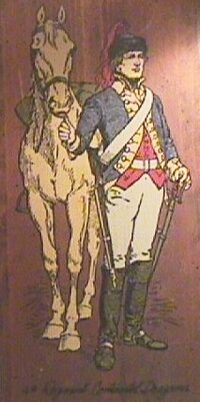
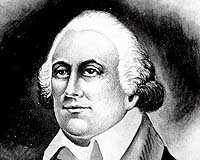
MOYLAN, Stephen, (1737-1811)
Muster-master General, Continental Army and Agent for fitting out Continental Navy ships; LtCol, aide to General Washington; Colonel and Quarter Master General (QMG);
Colonel, Commander of the 4th Regiment of Continental Light Dragoons,
Colonel, Commander of the Continental Cavalry
Continental Army Officer - Pennsylvania.

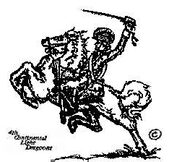
Stephen Moylan was born in Cork, Ireland, the son of a prosperous Catholic
merchant.
He was educated in Paris and Lisbon and spent three years in the
shipping business in Lisbon before reaching Philadelphia in l768. He quickly
achieved wealth and social standing. He engaged in commerce. On November 11,
1768, the brigantine "Richard Penn," of 30 tons, built at Philadelphia, James
Galoway, Master, was registered as owned by Stephen Moylan of Philadelphia. The
following April 7, 1769, the brigantine "Minerva." George Barwick, Master, 120
tons, is also registered. Stephen Moylan, owner.
On the recommendation of
his friend John Dickinson he was appointed Muster-master general of the
Continental Army on 11 Aug 1775. Joining General George Washington at Cambridge,
Massachusetts, his duties included the fitting out of privateers (the
Continental Navy).
An early advocate of complete independence, he had hopes
early in 1776 of being appointed ambassador to Spain. (Frank Monaghan in D.A.B.)
To General Washington
Philadelphia, JULY 25, 1775
Dear Sir.
Mr. Moylan, a friend of mine, informs me that he intends
to enter into
the American Army. As he resided some years
in this City and was much
esteemed here, I sincerely hope
he will be so happy as to recommend himself
to your favour,
which I am convinced he will endeavour to deserve.
I
heartily wish vou everv kind of Happiness and am, Sir.
Your Most Obedient
Servant.
JOHN DICKINSON
General Washington replied on August
30, 1775, and the General Orders of August
11, 1775 confirm his appointment as MUSTER-MASTER General.
Although
Moylan was appointed as MUSTER-MASTER General, his experience in the shiping
industry afforded the United States a well qualified ship outfitter, who would
help fit out the first ships of what would become the United States Navy. On October
4, 1775, Gen Washington appointed Col John Glover and Stephen Moylan to fit
out two "prime sailers, to put them in the best order and lose no time." The
letter sent, written by Reed, contained the following instructions to Col
Glover.
Mr. Moylan, the Muster-Master General is associated
with you in
this business; and whatever engagements
are entered into by you and Mr.
Moylan. when you may
happen to be together, or by either in case one goes
to Newbury, the General will fully ratify and confirm.
|
|
|
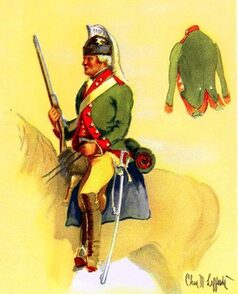
On March 5, 1776, he became secretary to General Washington. In the early years of the war (1775-76) certain lines of correspondence seem to have been assigned to certain aides; Stephen Moylan, for instance, wrote most of the letters relating to fitting out the armed vessels ("Washington's fleet," as it was called). On June 5, 1776, he succeed Thomas Mifflin as Quartermaster General. On June 7, 1776, Colonel Moylan left headquarters to take up his new assignment, which became an unsuccessful venture, although it must be pointed out that his difficulties were virtually insurmountable. Washington wrote Brother Samuel on 8 Oct 1776 that Long Island and NYC would have been evacuated of all material "but for a defect in the department of the Quarter Master General's not providing teams enough." (Freeman, Washington, IV, 196) Failing also in the business of procuring other equipment for the army, he resigned as QMG on 28 Sept 1776 and Mifflin was re-appointed to the post. "Moylan acted wisely and honorably in resigning," wrote John Jay to Edmund Rutledge. (Ibid IV, 211n) He remained on GW's staff as a volunteer, and about 12 December, 1776 he left for the Delaware to hurry the movement of Lee and Gates south to join the main army. (Ibid, 283n) A snowstorm prevented his rejoining in time for the action at Trenton, but he served with distinction in the victory at Princeton, January 3, 1777. (DAB)
Moylan responded to Washington's warrant to raise a mounted regiment, which started as the
1st Pennsylvania (a volunteer unit) Regiment of Cavalry but it became the 4th of the four Regiments of Continental Light Dragoons. Colonel Moylan was commissioned commander of the 4th regiment on Jan 5, 1777, an assignment he held for the rest of the war. He and his second in command, LtCol Anthony Walton White, and Major William Washington, were all ranked as the senior cavalry officers. Col White would later command the 1st Dragoons in the South and Major Washington would be promoted to LtCol and command of the 3rd Dragoons in the South. Moylan's 4th Dragoons had an inglorious start of making history by scaring the inhabitants around Woodbridge, New Jersey with their new Red regimental coats. General Washington soon put an end to the practice of any Continental Army units wearing red Regimental coats. The 4th Dragoon regimental coats were changed from blue faced red to red faced green coats.
The first year of the Continental Cavalry's existence was one of organization and training and further controversy as General Pulaski was appointed commander of the cavalry on Sept 21, 1777. Problems of cooperation and language came to a head the next month, when Colonel Moylan was unhorsed by one of Pulaski's lancers in a training exercise. Moylan was acquitted of court-martial charges pressed by Pulaski, after which Pulaski resigned his command in October. Pulaski would be given command of an independent Legion that would suffer a great defeat at Savannah in 1779 and Pulaski would die of wounds received in that action. Moylan became commander of the cavalry in March 1778. Amid this controversy, the British Army embarked upon the conquest of Philadelphia. And, after running the continental dragoons ragged all over the New Jersey countryside during the year, there were few continental dragoons available to act as Washington's eyes or to prevent the flanking movements of the British Army at Bradywine. The year 1777 closed out with Moylan and the 4th Dragoons protecting the winter encampment at Valley Forge.
An adequate cavalry arm would have been invaluable to Washington in the 1778 Monmouth Campaign. Despite inadequate numbers and worn equipment, Moylan struggled manfully to do the job with the 30 troopers left in service by 25 June. (Ibid, 19n) Moving ahead of the army from Englishtown, NJ, on that date, he got in front of the British Army the day before the Battle of Monmouth and furnished General Washington with some useful intelligence.
Stephen Moylan was married during the war (Sept 12, 1778) to Miss Mary Ricketts Van Horne, eldest daughter of Col. Van Horne (a loyalist) of Phil's Hill on Middlebrook stream a mile west of Bound Brook, New Jersey. Simcoe's Queen's Rangers went to Bound Brook intending to capture Moylan at Van Horne's but he was not there. An interesting notice of Col. Moylan and Capt. Heard, appears in Chastelleux's Travels, vol I, pp 142 -155, which is reproduced in the Moylan biography.
For the next three years Colonel Moylan served in the Hudson (Highlands Force) and in New York and Connecticut, maintaining a station a Pound Ridge. Colonel Moylan and the 4th Dragoons operated with Sheldon's 2nd Dragoons while in this theater. At this time, another independent or partisan corps took the field under Col Armand, a French adventurer. This time, however, Moylan was the senior (cavalry) officer, and no problems were encountered with the foreign officers, even though Armand's Legion was composed of the remnants of General Pulaski's Legion. Colonel Moylan and the 4th Dragoons wintered in Colchester, Connecticut during 1779 and 1780.
In July 1780, Moylan and Captain Zebulon Pike's troop took part in General Anthony Wayne's expedition at Bull's Ferry, NJ. The literate British Major Andre penned the poem "The Cow Chase" to record that historical event in prose. Also, in 1780, as events in the Southern theater of operations continued to grow darker, some of "Moylan's Virginia regiments of horse" are referred to as taking part in the Charleston campaign of 1780 (Ward, W.O.R., 701). The term "Moylan's horse" may be used in the sense of Moylan being commander of the Continental cavalry. By this time, both LtCol White and Washington were on the scene in South Carolina, and they were to be joined by Light Horse Henry Lee's legion. It is known that detachments of 4th Dragoons were in the Carolinas or the south, but Moylan himself stayed close the GW's HQ with the Highlands Force. It is very likely that Moylan sent some 4th dragoons with William Washington to fill out the 3rd Dragoons, which had been decimated in an earlier action at Tappan, New York.
In May 1781, the 4th Dragoons were in Lancaster, Pa, under the command of Major Fauntleroy. Colonel Moylan and the regiment were ordered to join Generals Lafayette and Wayne in Virginia. However, no actions are known for this part of the regiment until it arrived at Williamsburg and then moved on to Yorktown with the allied army of Washington and Rochambeau. The Order of Battle for the siege indicates that Moylan was present with 60 4th dragoons. (Johnston, 113, the Siege of Yorktown.) After Cornwallis' surrender Colonel Moylan was ordered to take the cavalry to General Green in South Carolina. However, poor health forced Moylan to return to Philadelphia. By the end of the war, he was rewarded for his services by being breveted Brigadier General on Nov 3, 1783, the date he left the army.
Stephen Moylan died in Philadelphia, April 11, 1811 and is buried in St. Mary's church-yard, South Fourth St, Philadelphia.
Colonel Moylan was a jovial Irishman who cut quite a figure in what Monaghan describes as "his very remarkable uniform, consisting of a red waistcoat, buckskin breeches, and a bright green coat and bearskin hat." (DAB) President Washington appointed him commissioner of loans in Philadelphia in 1793. In 1771 he was the first president of the Friendly Sons of St. Patrick, and in 1796 he was re-elected to this post. One of his brothers was Bishop of Cork, another, Jasper, was a lawyer in Philadelphia, and a third, John, was a Philadelphia merchant and Clothier General of the Continental army.
The children of Colonel Stephen Moylan were a still-born child, March, 1780, at Middletown, Connecticut; two daughters, Maria and Elizabeth Catharine
and an infant interred in St. Mary's graveyard, Philadelphia, February 24, 1795.
Elizabeth Catharine was married on March 10, 1807,
by Rt. Rev. William White, Episcopal Bishop of Pennsylvania, to William Moylan Lansdale,
her first cousin. His father, Major Thomas L. Lansdale, had married Cornelia Van Horne.
Maria was baptized at St. Mary's, Philadelphia, March 5, 1786.
Thomas FitzSimons and wife and John and Jasper Moylan and Isabella Mease were sponsors. She married Samuel Fox.
Isabella Mease was the widow of James Mease and the fiancé of Jasper Moylan.
Col. Moylan and Jasper were half-brothers.
A fifth brother, James was business agent to the American Commission in Paris consisting of Benjamin Franklin, Thomas Jefferson, and John Adams.
James Moylan was integral to the purchase and outfitting of the Bon Homme Richard, commanded by John Paul Jones.
The Biograpy of STEPHEN MOYLAN
Muster-Master General
Secretary and Aide-de-Camp to Washington
Quartermaster-General
Colonel of Fourth Pennsylvania Light Dragoons and
Brigadier-General of the War for American Independence
The First and the Last President of the
Friendly Sons of St. Patrick of Philadelphia
COPYRIGHT, JANUARY 16, 1909
By MARTIN I. J. GRIFFIN
Frank Monaghan, wrote "Stephen Moylan in the American Revolution" for Studies:
an Irish Quarterly Review (Dublin), Sept 1930.
This monograph includes the Monaghan material from
The Encyclopedia of the American Revolution
by Mark Boatner
David McKay Company,
New York, 1966.

The following list contains the GW Papers index entries for the Moylans in the Revolutionary War.
V38P450 Moylan, Colonel Stephen, * 1.XLIV (in text above) Mustermaster General, 3.414, 419, 428, 459, 508n; Military Aide, 4.6, 31, 32, 102n, 104, 268, 369, 381, Quartermaster General, 5.1, 12, 21, 105, 106, 156, 157, 184, 233, 481; 6.2, 11, 46, 47, 68, 103, 116n, 120, 126, 193, 233, 324, 341, 362n, 367, 407, 454, 473n Cavalry command, 7.31, 51, 322, 419; 421, 4th Dragoon command 8.53-56, 98, 121n, 136, 197, 203, 437, 447, 472, 473, 475, 479, 488; 9.29, 36, 68, 69, 81, 82, 99, 214n, 242, 245, 288, 379, 404, 9.472; 10.31, 139, 228, 256, 369, Winter Quarters, 11.147, 149, 203, 244, 322, 338, 385, 398n, 420, 446, 469, 470, Monmouth, 12.2-3, 80, 108, 162, 205, 228, 248, 249, 290, 470, 530, 13.25, 284, 351, 356, 357, 371, 397, Arnold trial, 15.182, 327, 328, 337, 338, 373, 395, 399, 437, 471, 473, 474, Dismounted men, 16.34, 56, 85, 86n, 329, 382 17.116, 146-7, 199, 200, 202, 210, 287, 291, 318, 322, 355, 392, 394-5, 402, 482, 18.3, 14, 18n-19, 25, 39, 53, 90-91, 101-2, 167-8, 219, 280, 282, 291, 295, 495 19.46-47, 70, 99, 123n, 139, 142, 216, 260-62, 276, 414, 441, 466, 506; refit for south, 20.20, 120, 141, 251, 187, 361-2, 337, 381-2, 385, 395, 419, 441, 499, Yorktown 21.294, 306, 314, 415, 416, 431, 471, 22.353, 23.194, 198, 290, 216, 270, 312, 317n, 319, 141, 220, 266, 317n, 375, 423, 434 24.82; 25.163, 182, 466, 467; Mount Vernon, 28.142; Federal Office, 30.413, 33.134n, 37.542n See also Cavalry; Fourth Dragoons. Journals of the Continental Congress - Page Index by Year 1776 - Quartermaster-General; 419, 428, 566, 838, 839, 844n, 865. 1777 - Colonel 4LD; 158, 168, 238, 365, 374, 382, 406, 449, 567, 593, 608. 1778 - Colonel 4LD; 1147 - Major Washington promoted to LtCol 1779 - Colonel 4LD; 430. 1780 - Colonel 4LD; 363, 364, 509n, 716. 1781 - Colonel 4LD; 149, 319, 402. 1783 - Colonel 4LD; 748n; letter, 800. Moylan, Mrs. Stephen, 16.330. Moylan, James, 21.416 In leter to Stephen April 4, 1781. COMMERCIAL AGENT AT L'ORIENT Moylan, John,* Clothier General, 17.70, 300, 18.59n, 127, 19.213, clothing, 21.246, 283, 371, 22.40, 12n, 63; 24.77, 457, 458, 25.66, 126, 207, 313, 375, 26.32, 27.178, 206, 207, 222, 242. Journals of the Continental Congress - Page Index by Year 1780; 509n. 1781; 505, 634, 636, 644, 662, 719, 852, 856, 898, 902, 948.

Contact Us
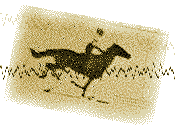
Thank you for your interest.
Email us at:iv_dragoon@email.comor sign the guestbook and make your presence known.
